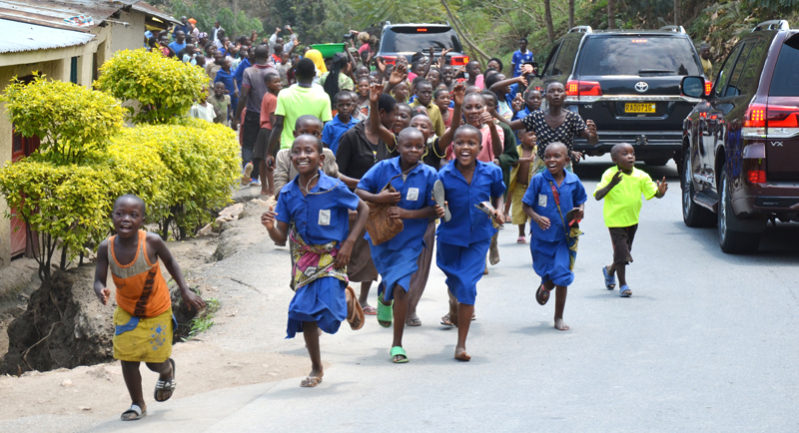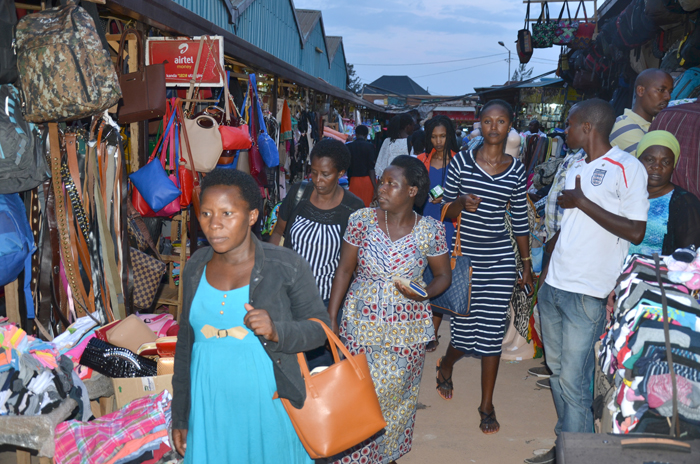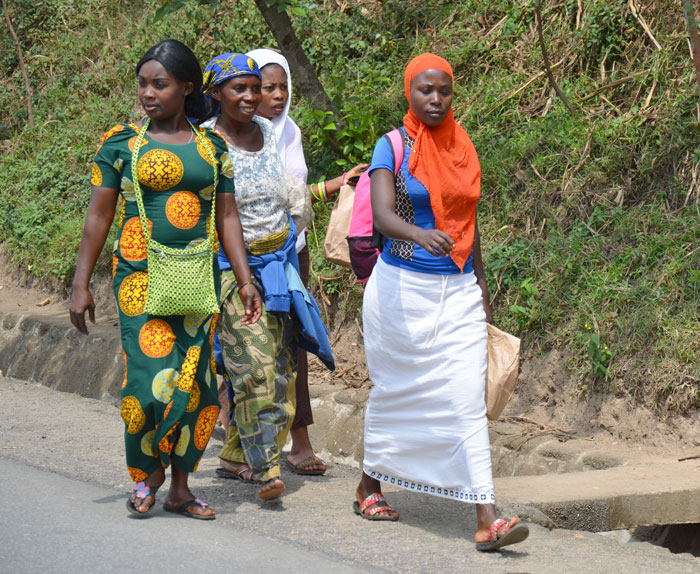Twenty-four years after a horrific genocide claimed more than a million lives, Rwanda boasts the cleanest, safest, business-friendly country in Africa
By David DeVoss
We rose before dawn and began driving across Rwanda, a densely populated East African country on the edge of the Great Rift Valley from which springs the headwaters of the Nile. As the sun rose above the misty hills the roadsides filled with brightly dressed women balancing bundles atop their heads and men pushing bicycles piled high with agricultural produce. A mountainous, landlocked nation that calls itself “The Land of 1,000 Hills,” Rwanda has 12 million people who live in a country smaller than Maryland.
Our destination was the Akagera National Park, an undulating slice of savanna along the Tanzanian border that contains a protected wildlife park. The park originally covered 965-sq. miles, but in 1997 it was reduced in size by two-thirds to provide cropland for homeless refugees.
I had come to see herds of elephant and giraffe nibbling acacia branches, but after several hours driving around the park the most prevalent mammal seemed to be ibex and warthogs.
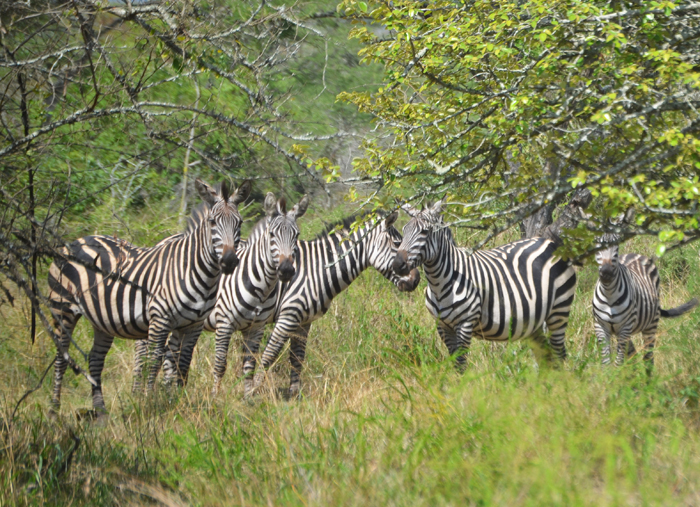
Zebras can be found in abundance inside the Akagera Wildlife Park, but don’t expect to see many elephants, rhino, leopards or giraffe since breed pairs from surrounding countries have yet to multiply.
“Where are all the lions and leopards?” I asked community park guide Nishimwe Daniel. “Eaten,” he explained, “by starving survivors of the1994 genocide.”
“We started repopulating the park several years ago,” he quickly added, “and now have 22 lions, 11 species of antelope and some black rhinos in addition to giraffes, elephants, hippos, buffalo and leopards. It just takes a while for them to get comfortable and reproduce.”
If Americans have difficulty remembering what happened in Rwanda in 1994 it’s probably because they were preoccupied at the time with OJ Simpson, the Tonya Harding scandal and the suicide of Kurt Cobain. U.S. newspapers with correspondents in Africa mischaracterized the looming massacre as a continuation of a four-year civil war pitting Hutu farmers, who controlled the country, against Tutsi herdsmen under attack for the past 30 years. Just another tribal war, folks. Nothing to see here.
Violence began April 6 when the plane carrying President Juvénal Habyarimana was shot down on its approach to Kigali airport. By the next day Hutu extremists had seized control of the government and directed mobs armed with clubs and machetes, to set up roadblocks and begin killing Tutsis – and any other person moderate enough to support them. Tutsis were easy to identify since every Rwandan was required to carry a national identity card stamped with his or her ethnicity.
Among first to fall were 10 UN Blue Berets from Belgium. Their slaughter was so savage that Rwanda’s former colonial master immediately withdrew from further UN peacekeeping efforts. UN Secretary General Boutros Boutros-Ghali then asked Washington to intercede. But the Clinton Administration, still reeling from the 1993 “Blackhawk Down” fiasco in Somalia, wanted nothing more to do with Africa.
Hutu machetes often resulted in prolonged agony. Mutilations were common as was sexual abuse of women. Babies were smashed against rocks or thrown alive into pit latrines. By the middle of May garbage trucks in Kigali had collected 60,000 bodies and buried them in mass graves.
“Brutality here does not end with murder,” reported the Economist. “At massacre sites, corpses, many of them children, have been methodically dismembered and the body parts stacked neatly in separate piles.”
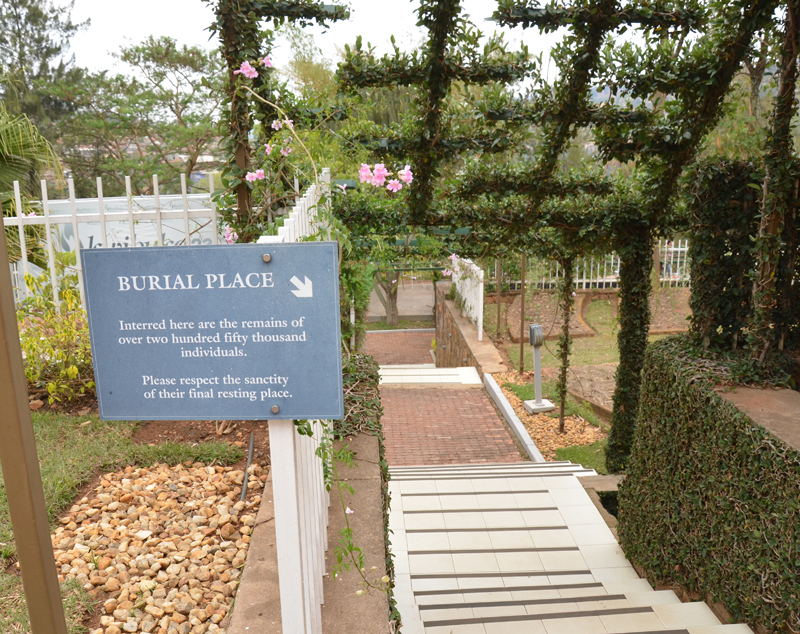
Located in the center of Kigali, Rwanda’s Genocide Memorial, like Yod Vashan in Jerusalem, is a place for respectful contemplation
By June bodies were piling up at the rate of 10,000 a day but for French President François Mitterrand the real concern was that French-speaking Hutu might lose Rwanda to the English-speaking Tutsi army marching south. Not since defeats in Indochina and Algeria had Paris lost a member of La Francophonie, the international union of French-speaking countries. To prevent that outcome he ordered 80 tons of weaponry flown to Kigali. The shipment included thousands of fragmentation grenades intended for use against the “Khmer Noir.” Hutu genocidaires instead threw them into crowds of Tutsi refugees.
When violence finally abated 100 days later on July 4, almost 1.1 million people lay dead. Seventy-five percent of the Tutsi population inside the country had ben killed, as well as the vast majority of the moderate political and civic voices.
I came to Rwanda with a production company filming Rwanda: The Royal Tour, a travel documentary that aired recently on PBS. The series is produced by Peter Greenberg, the Emmy-winning CBS travel editor who convinces heads of state like Jordan’s King Abdullah and Israeli Prime Minister Benjamin Netanyahu to spend a week showing him around their country while cameras are rolling. Greenberg has produced seven Royal Tours, accompanying heads of state into the Amazonian jungles of Peru, Ecuador’s Andean markets and the alpine valleys on New Zealand. But timing a tourism program to coincide with the 24th anniversary of Africa’s most horrific genocide seemed unusual.
“When I told people I was going to Rwanda they told me to be careful and stay safe, but their concern is based on circumstances that no longer exist,” says Greenberg.
“The Gallup Global Law and Order Report rates Rwanda as the second safest country (after Algeria) in Africa. The World Bank ranks it No. 1 when it comes to the ease of doing business. As for cleanliness, there’s no dispute that Kigali is the cleanest city in Africa. Rwanda really has a lot to offer.”
Modern Rwanda is creation of Paul Kagame, a bespectacled 60-year old former guerilla leader who grew up in a Ugandan refugee camp after his Tutsi parents in 1960 were forced to flee Kigali in advance of a Hutu mob. Despite his Rwandan nationality, Kagame joined the Ugandan army and may be the only military commander to receive training in both Cuba and Ft. Leavenworth, Kansas’ US Army Command & General Staff College.
Kagame certainly is the most successful general alive. At age 28 he helped topple Ugandan dictator Idi Amin. Eight years later he ended Rwanda’s genocide with an army largely composed of Tutsi refugees. In 1996, following repeated border incursions by Hutu génocidaires based in Zaire (now known as the Democratic Republic of the Congo), Kagame, at age 39, sent Rwanda’s tiny army into a country more than three times the size of Texas and toppled dictator Mobuto Sese Seko.
Over the 24 years Kagame’s Rwandan Patriotic Front (RPF) party has been in power, the economy has grown between 7% to 8% a year. Per capita income of $150 at the end of the genocide now stands at $700 and is expected to climb to $1,100 by 2020. Rwanda remains the world’s 20th poorest country, but life expectancy is up and infant mortality is down. Health improvements stem from the fact that 91% of the population has medical insurance and 100% of the people in Rwanda’s 15,000 villages receive free eye care. Medications and blood test results are delivered directly to individual homes in remote locations by drones operated by a Silicon Valley company called Zipline. Controlled from two distribution centers, the fixed wing drones can carry up to 4-lbs.of cargo and have a round-trip range of 99 miles.
Foreign aid donors provide almost all of Rwanda’s health budget, as they do in most other African nations. But in Rwanda the money actually gets spent for its intended purpose.
Kagame’s commitment to the environment starts at the airport where plastic bags carried by incoming passengers summarily are shredded. Outside the terminal streets leading into town are free of litter, graffiti, homeless encampments and prostitutes. Traffic flows in an orderly fashion and there are no vendors coming up to cars at stoplights.
Most African countries have a presentable capital with some nice neighborhoods and clean streets. What distinguishes Kagame’s administration is the effort to bring government benefits to rural areas. He has used aid money not only to improve highways but also to build a fiber optic network, which provides remote districts with cell phone reception and Internet connections. Recently, a San Francisco company called Off Grid Electric began installing solar panels atop homes that allow families to charge their phones, have lighting at night and avoid the expense of buying kerosene.
Special efforts are made to keep rural communities cohesive. The Girinka program initiated in 2006 gives dairy cows to poor families to improve nutrition. The family repays the government by giving their cow’s first calf to a needy neighbor.
Rich and poor alike are expected to spend the last Saturday of every month working with their neighbors to clean and improve their surroundings. Known as umuganda, these national days of community service often are spent building schools. As a result, 90% of Rwanda’s youth attend school where many receive a laptop computer to share with other students.
“Paul Kagame has made amazing progress despite having inherited one of the most tragic situations in the developing world,” says former Haitian Prime Minister Laurent Lamothe, 45, who now heads the Miami-based Global Voice Group. “He’s a dedicated conservationist working to make Rwanda into a premier tourist destination. I understand why the people of Rwanda have elected him three times.”
The popularity the RPF is beyond doubt. When Kagame ran for president in 2003 and 2010 he was elected with 95% and 93% of the vote. Had he retired from politics in 2017 and accepted a UN sinecure he would be revered as the George Washington of Africa. But in 2015 the RPF proposed a constitutional amendment that would abolish the two term limit for presidents. Last August Paul Kagame was reelected for a third term with 98% of the vote. Legally, he can remain in power until 2034.
Kagame’s long goodbye does not seem to have damaged him domestically, but NGOs, academics and a number of diplomats believe he and his party may be taking the dark path earlier trod by Zimbabwe’s Robert Mugabe and South Africa’s Jacob Zuma. Rwanda’s “development miracle” now often is described as “impressive but repressive.”
“He’s been in power since 1994,” notes Ruth Iyob, 60, an Africa specialist at the University of Missouri, St. Louis Center for International Studies. “Is 24 years going to turn into 40? Rwanda is clean and runs well, but so did Mussolini’s Italy.”
Kagame insists his role models are Lee Kuan Yew of Singapore and Malaysia’s Mahathir Mohamad. Human Rights organizations like Amnesty International, Reporters Without Borders, Freedom House and Human Rights Watch, however, believe his successes are tarnished by press intimidation and the exile or imprisonment of political opponents.
Rwanda’s president is a complicated politician who governs in a challenging corner of the world. Is he autocratic or merely authoritarian? After ending the genocide he abolished the death penalty, released thousands of prisoners to participate in reconciliation, took a strong stand against homophobia, encouraged women to run for government office and removed all ethnic and social references from identification cards. His “One Rwanda” policy is strictly enforced to the point of penalizing those who openly advocate divisiveness.
According to the “Global Competitiveness Report,” Rwanda is the best place in Africa to be a woman. Women occupy 64% of the seats in Parliament, hold 42% of the cabinet posts and fill 40% of the judgeships on the Rwandan Supreme Court.
These reforms don’t feel like the acts of a traditional African strongman.
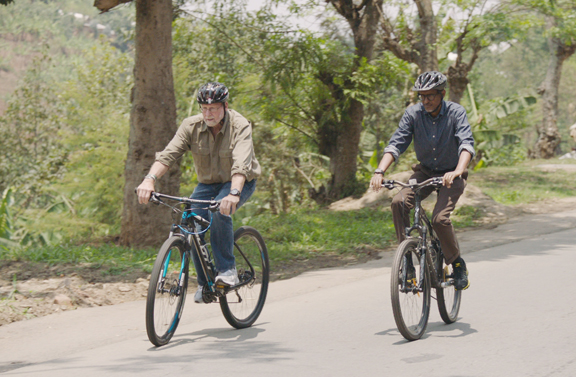
Royal Tour producer Peter Greenberg and Rwandan President Paul Kagame point their bicycles downhill toward Lake Kivu in western Rwanda
On the third day of The Royal Tour action shifted to the mountains surrounding Lake Kivu in the western part of the country. Greenberg and the President were scheduled to ride bicycles down a hill while wiry competition cyclists belonging to Bike Rwanda zoomed up. The scene would give Kagame the opportunity to tell viewers that Rwanda is the Land of 1,000 Hills. In the afternoon they would take jet skis out on Lake Kivu. So morning would be the best time to ask Kagame about international criticism of his administration.
I approached Rwanda’s president while a PBS technician was attaching a camera to the handlebar of his bike and after exchanging several pleasantries I asked how he responded to criticisms that Rwanda’s democracy falls short of western standards. “Westerners consider their democratic model as the only viable one,” he explained, somehow managing to look professorial in a bike helmet. “An inflexible model can easily become an alien imposition. Our country is not America. We are different. Yes, we share common values, but we have to make a democracy that takes our culture and values into account.”
Rwandans believe most of the pain they’ve experienced over the past century directly results from Western values. German explorer John Hanning Speke stumbled into the country while searching for the source of the Nile. He immediately dismissed the Twa, a pygmoid group of hunter-gathers, and the Hutu as inferior due to their short stature and dark skin. Tutsi, on the other hand, were tall and angular with “Semitic and even Jewish features” Germans at that time found attractive.
After Berlin’s defeat in World War I, Belgium inherited Germany’s African colonies and its anthropological prejudices. It institutionalized the racial hierarchy so that ethnicity became identity. At the end of World War II, a new generation of Flemish colonial administrators discarded the Walloon values of their predecessors and began putting Hutus in charge. Giving power to the largest ethnicity seemed logical in a period of decolonization, but when Belgium finally left the country in 1962 chaos ensued.
“Colonialism came in, favored one group, then favored another and then left,” says University of Southern California Professor Amy Marczewski Carnes, who manages USC’s Shoah Foundation. “Decolonization laid the groundwork for the genocide.”
Three takes are necessary before the director is satisfied with the morning’s work. Bike Rwanda is exhausted and the film crew is ready for lunch. As a production assistant unhooks Kagame’s wireless microphone, he motions me over for another conversation.
He’s worried that I not misinterpret his earlier remarks. He admires America so much that all of his children attend U.S. colleges. What he does not like are the New York Times and the Washington Post.
“The cynicism of your media makes them believe that if things are smooth and stable in Africa there must be something hidden and wrong. Rwanda is clean and safe with an economy growing more than 7% a year but they write about soldiers on the streets of Kigali.
“There are more than 150,000 heavily armed guerillas living in refugee camps just across the Congo border that want to destroy this government. Our soldiers are meant to reassure Rwandans that never again will they be attacked. They are also a visible warning to those who would do us harm that there is a line that can’t be crossed.”
The next destination is Lake Kivu, a pristine body of water Rwanda shares with the Congo. The only road there leads through a small town whose residents pour into the street as the presidential SUV approaches. It’s an unscripted moment and some of the cameramen are missing.
When President Kagame exits the car adults going home for lunch and excited children heading home from school surge toward him, singing a song from his 2017 reelection campaign called “There’s No Fight.” It tells the story of the RPF’s desperate 1990 escape from government forces intent on their destruction. Short of food and winter clothing Tutsi rebels raised in Ugandan refugee camps found refuge alongside bands of gorillas American primatologist Dian Fossey had died trying to protect five years before.
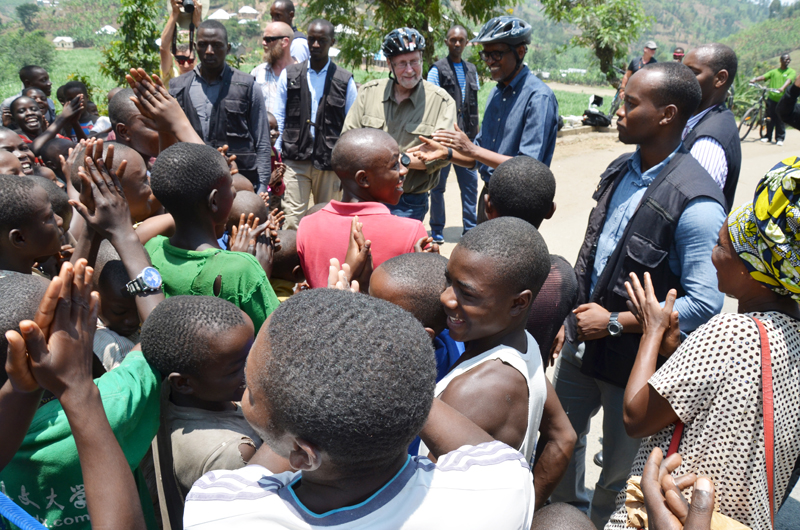
Villagers going home from lunch surround the car carrying Rwandan President Paul Kagame and Royal Tour Producer Peter Greenberg so they can celebrate their president with dancing and song.
“Just as God protected Kagame in the mountains, Now that same God Potects us all”
The following day, the PBS crew heads to those same mountains where the President will escort Greenberg high into Volcanoes National Park to meet some of Rwanda’s most iconic residents. Gorillas are Rwanda’s most valuable attraction and en route to the jungle Kagame still wants to talk about America.
“When I go to the U.S. I like to visit New York, Chicago and LA, not Washington DC,” he smiles. “I hate going to the State Department because it’s just politics with them and you end up doing nothing.”
Kagame’s goal on business trips is to meet American business people who will invest in Rwanda. “Instead of relying on USAID, I’d rather look for a private company that will come here and create good jobs,” he says. “That’s what builds a country. I’d rather host a Chamber of Commerce tour than a delegation of state governors.”

He doesn’t look like a cash cow, but that’s the function gorillas perform in Rwanda’s tourism economy. Want to see the gorillas? It will cost you $1,500 per person for a one-hour visit.
Rwanda underscored its determination to join the international business community in 2008 by withdrawing from La Francophonie and making English the official language used in secondary education. The following year it joined the British Commonwealth of Nations.
But its most prescient decision may be prioritizing tourism as the economic sector most essential to national development. Tourism generates nearly $8.38 trillion in worldwide revenues and accounts for one out of every ten jobs or 10.2% of global GDP, according to the World Travel & Tourism Council.
Not all Americans starting new enterprises in Rwanda are business people. Crystal Rugege is a computer scientist with an MA in Information Systems Management who spent seven years in Silicon Valley working for IBM before moving to Rwanda six years ago to create a Kigali campus for Carnegie Mellon University. Already 100 students have graduated with degrees in electrical engineering, computer science and information technology. Next year she will open a larger campus with an innovation incubator that will accommodate 300 students.
Born in Champaign, Ill to parents from Rwanda and Uganda, Rugege says she’s found a home in Rwanda. “The country offers a results-oriented, business friendly environment and has serious students dedicated to developing the East African region.”
The Rwandan government hopes Kigali will become the center of Silicon 1,000 Hills, but until that happens tourism remains Rwanda’s largest industry, generating $400 million equal to five percent to total GDP. The U.S. already accounts for a third of the country’s tourist visitors and the number should grow when Air Rwanda starts flying to New York in August.
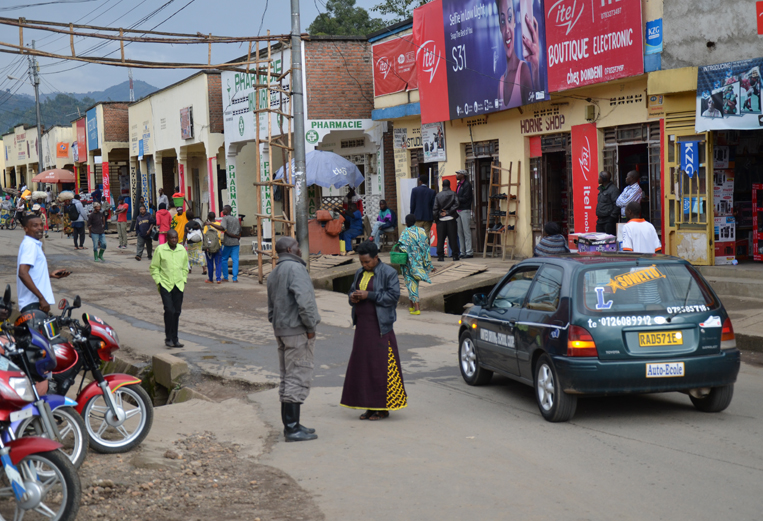
Rwanda is a poor country but it is exceedingly clean with no trash or graffiti visible even in the smallest of rural towns
Private developers are pledging $144 million to construct new hotels. Most will be built in the capital, but the more luxurious properties will accommodate travelers come to see mountain gorillas. Last year, 22,708 foreign visitors paid $16.8 million for a permit allowing them to take an arduous hike through a rain forest to watch gorillas from afar. The revenue stream will increase this year since gorilla permits recently doubled to $1,500.
“Rwanda’s tourist attractions will adopt the Tahiti pricing model instead of the mass marketing strategy found in Hawaii,” explains Rwanda Tourism Marketing Manager Linda Mutesi. “We believe a premium product merits a premium price.”
When Paul Kagame began designing a new constitution for Rwanda most western government, including the U.S., advised him to create a system of quotas in which government jobs, college scholarships, bank loans would be apportioned between Hutu, Tutsi and Twa (Rwanda’s third ethnicity) based on their percentage of the total population. Kagame refused. He argued that segmenting Rwandan society along ethnic lines by the Germans, Belgians and French was the prime cause of the genocide. There would be no more set-asides. The modern Rwanda would be One Rwanda.
In today’s America, universities, political parties, banks and social media platforms now sort aggregated data into demographic silos. The idea of a melting pot has become a micro aggression on many college campuses. Since America no longer values its motto, perhaps we should give it to Rwanda. E pluribus unum certainly complements the One Rwanda policy.![]()


